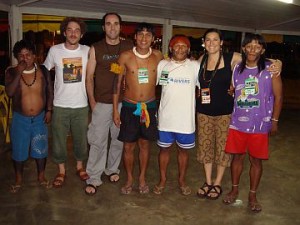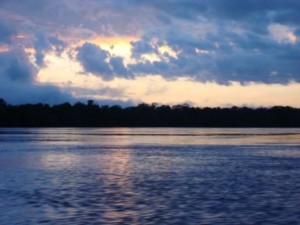***NOTE: This is essentially a report on the historic gathering, from my perspective. I meant to post daily blogs, but internet access in Altamira was non-existent in the hotel I stayed in. Enjoy!***
Thousands of people gathered in Altamira, Para-Brazil last week for the “Encontro Xingu: Vivo Para Sempre” or “Xingu Encounter: Alive Forever” gathering. This gathering brought together local, national and international organizations, including RAN, working to defend the Xingu River Basin and support the Indigenous and river-based communities that inhabit the region in their resistance to proposals to dam the Xingu river. This was the largest Indigenous gathering in the Brazilian Amazon since 1989 when a similar gathering took place in Altamira. After attending the historic gathering this week, traveling to the proposed dam site and flying over the entire Xingu river basin, it is very clear to me that local and Indigenous communities are totally against the current dam proposals and that everything must be done to protect the Xingu river basin and its inhabitants.
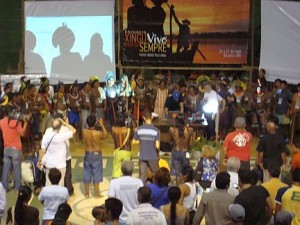
For those of you who do not know, the Xingu river is one of Brazil’s largest rivers and one of the largest tributaries to the Amazon river. Its headwaters are in the state of Mato Grosso, “the soy state”, then it travels through the Xingu Indigenous Reserve until finally reaching the Amazon. The 10,000 square mile Xingu Indigenous Reserve was the first federally recognized Indigenous territory in Brazil. The Reserve is home to more than 4,000 people from 14 Indigenous nations – including the Aweti, Kaiabi and Waura– each with a distinct language and cultural tradition. Another 10,000 Indigenous people, including the Kayapo, Panara and Xavante nations, live along the river in areas outside the Reserve. The entire Xingu river basin and the lives of its inhabitants are under threat by dams -both large and small- and industrial agriculture. Soy plantations dominate the upper Xingu surrounding the Reserve contaminating the river and its tributaries with toxic pesticides and fertilizers.
And, if the state electric company gets its way, a series of dams beginning with the gigantic BELO MONTE dam in the lower Xingu will be built to “meet Brazil’s growing energy needs”.
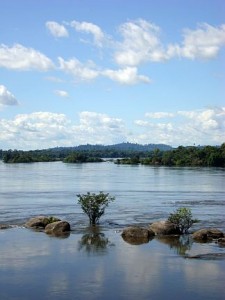
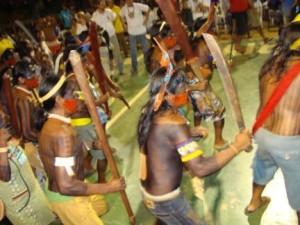
To show their resistance to Electrobras’s dam proposals and other threats to the Xingu river basin, over 1,000 Indigenous people traveled by canoe, boat, bus and plane to participate in the Xingu Encontro this week. At the opening ceremony Monday night, each tribe individually entered the gymnasium where the meeting was being held singing and dancing to show their presence and resistance. They were greeted and honored by hundreds of community members, students, NGO representatives and the media as they entered the meeting. As the meeting kicked off, leaders from local community organizations addressed the crowd about their concerns and then, a leader from each tribe addressed the crowd and asked the media to tell the world about their concerns. Luckily, AP, CNN, BBC, NPR, Aljazeera, independent media, and loads of local and national Brazilian press were in attendance.
WATCH BATTLING FOR WATER IN THE AMAZON by Aljazeera on YouTube
Battling for Water in the Amazon
Tuesday, May 20, 2008: Electrobras presentation ignites anger at Xingu gathering.
The day began in an opening ceremony as each tribe entered the meeting. Following the ceremony and introductions, Father Renato gave an overview of the historic 1989 gathering. He also pointed out the work of anthropologist Darrell Posey who traveled to the United States with two Kayapo leaders to lobby the U.S. Congress to cancel loans for the proposed dams. As a result, $8 million in World Bank loans were cancelled. Unfortunately, however, plans for dams on the Xingu have not been cancelled indefinitely.
In the afternoon, an engineer from Electrobras, Paulo Fernando Rezende, presented his new analysis of the benefits and impacts on communities and the environment as a result of the construction of the Belo Monte dam. If constructed, it would be the 3rd largest dam in the world costing upwards of $6 billion dollars to construct. Mr. Rezende explained the growing need for the growing demand for more energy in Brazil. “Brazil needs an additional 32.4 million MWH/year over the next 10 years to meet its growing energy needs.” He was booed! Electrobras’s plan is to build Belo Monte and another 69 dams in the Amazon over the next 30 years. NOTE: Mr. Rezende failed to mention the additional 69 dams. He mentioned that Belo Monte would bring economic prosperity to the region and “jobs” for local and Indigenous people. He was booed! He acknowledged that there would be impacts, but that Indigenous lands would not be flooded. He was booed! He said that Electrobras would coordinate with FUNAI (Brazilian Bureau of Indian Affairs) to “consult” with Indigenous people. At that point, he was really booed!!! He was essentially booed off stage for lying about the impacts. Even though everyone knows that dams flood or dry up sections of rivers, displace communities, destroy fish stocks and intensify climate change, he said that the dams would not flood local communities. I think what really got to people, though, was the fact that Mr. Rezende totally disregarded the arrival of a tribe from the Xingu Indigenous Reserve during his presentation. He continued to give his powerpoint as the tribe entered with a ceremonial dance until he was asked by one of the meeting organizers to stop. To me, this is a clear example of the lack of cultural and environmental awareness that Electrobras and other companies have. I can’t imagine how their consultation of Indigenous and local communities would be without the presence of thousands of people and the media.
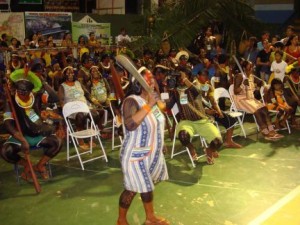
In response, Tuira Kayapo –a very strong Kayapo woman- stood up, walked over to Mr. Rezende waving her machete and gave him a piece of her mind. She’s the same woman who slapped an Electrobras official with her machete in 1989. Immediately following, the room cheered, Indigenous leaders began chanting and then all got up and headed towards Mr. Rezende to give him a piece of their collective and unified mind and presence. I didn’t understand what they said in words, but it was very clear that they were angry and not going to let Mr. Rezende or Electrobras leave without knowing that they were going to resist the building of this and any other dam on their traditional territories. They were clear that they will defend their lives, culture and their environment until the end. It was an amazing show of force and unity among the Indigenous people of the Xingu river basin, people who haven’t always gotten along, however the force ended in an unfortunate way. Surrounded by hundreds of Indigenous people and the media, Mr. Rezende was knocked to the floor and suffered some machete wounds sending him to the hospital. This promptly ended the meeting for the day to ease tensions. You can read more about what happened in an Associated Press article that was published on Tuesday night, or read blogs from friends/allies at International Rivers or the Indigenous People’s Cultural Support Trust.
The moral of the story, for me, is that Brazil has a long way to go to really put FPIC -Free, Prior and Informed Consent- into practice. Perhaps Electrobras has been “consulting” communities over the past 20 years, but consultation is not consent! If the people who are most affected (ie.. the Indigenous and river-based communities of the Xingu river basin) express their adamant opposition to a project, there is no project in my opinion. “Development” projects conceived in boardrooms in Sao Paulo need to be reconceived and “growth” needs to be re-evaluated for the true benefit of local and Indigenous communities and for our global environment and climate. Imagine what local and Indigenous communities could do with $6 billion dollars. Another World is Possible!
Wednesday, May 21, 2008: Visioning and Dancing to Protect Xingu
The confrontation with the Electrobras official on Tuesday, raised concerns by the organizing committee and created a media frenzy, but it did not stop the spirit of resistance at the event. The event continued as planned on Wednesday with workgroups focusing on future work to protect the Xingu river basin.
On Wednesday afternoon, I observed a visioning meeting of people from the Xingu Indigenous Reserve and learned about the values that Indigenous people have for the Xingu river basin. A Kaiabi Suia man said, “The Xingu river is our mother. The forest is our father. The river provides water and fish and the forest provides food and medicine for us. The forest is our supermarket. Without it we cannot live.” A Xavante man said, “The rivers of the Xingu basin provide water, biodiversity and cultural diversity. This is the type of energy we need, not energy from dams.”
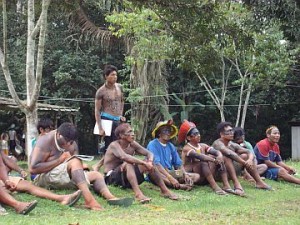
Following the meeting, Scott Fitzmorris (from the Wallace Global Fund), Zachary Hurwitz (Master’s Student at UT Austin) and I were invited to have dinner at the Betania where all of the Indigenous people were staying. While we were eating hundreds of people ran towards the kitchen to watch the evening news. A local news station reported that Mr. Rezende, the Electrobras official, was sent to the hospital and received 6 stitches from the wound he received on his arm. People cheered! Then the station ran an interview of a FUNAI (Bureau of Indian Affairs) official who denounced the “attack” and said that “the Indians would be held accountable”. People began yelling and chanting in anger. Then, the Kayapo stood up and began chant war songs and began to dance. They inspired the Kamaiura, Kaiabi, Suia, Kuikuro, Xavante and all the tribes present to join them. What began as a dance of resistance against the words of the FUNAI official, turned into a dance of unity of all of the tribes that lasted many hours. For the first time, I saw Kayapo Chiefs smiling, Kayapo women dancing with Kuikuro Chiefs and non-Indigenous allys being invited to dance with the group. It was a beautiful show of unity and strength that I will never forget. This is the type of energy and spirit that is needed to stop the dams and protect the Xingu river basin.
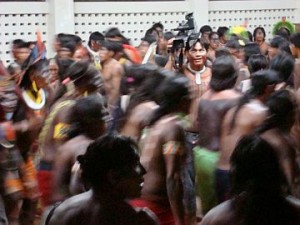
Thursday, May 22, 2008: Xingu Gathering ends in unity against dams on the Xingu and in the Amazon.
The day began with presentations by academics and government officials about the importance of FPIC –Free, Prior and Informed Consent. Then, the Indigenous people voiced concerns about NEVER being consulted, nor EVER giving their consent to build dams on the Xingu river. They said that even if they were consulted, they would never give their consent.
In the afternoon, the different work groups (ie…Indigenous from the Reserve, Indigenous outside the Reserve, river people, and city people) gave reports of their working group meetings on Wednesday. Then, the closing ceremonies began. Local leaders from Altamira and Chiefs of every tribe expressed their final thoughts and words to the Public Defender, the President of COIAB (Indigenous Federation of the Brazilian Amazon) and the entire audience. Then, the Brazilian National Anthem was sung and the meeting officially ended.
Friday, May 23, 2008: Closing Ceremony and Declaration.
In a symbolic gesture to show the deep respect and dependence that Indigenous and river people have on the Xingu river, they gathered on the banks of the Xingu on Friday morning. Indigenous people danced, Kayapo women bathed their children, and fish were caught. Final words of protest against dams on the Xingu and demands to the Brazilian government were read. You can read more about the closing ceremony in an AP article published on Friday. On Friday afternoon, the official meeting declaration entitled, “Carta Xingu Vivo Para Sempre” was released in Portugese. In sum, these are the demands formed by the working groups of Indigenous, river and city people that participated in the meeting:
1. Creation of an official Xingu Working Group to plan for the future of the Xingu, beginning with gatherings of Indigenous tribes;
2. Consolidation and protection of all Indigenous and public lands in the Xingu River Basin;
3. Immediate creation of an Extractive Reserve in the Mid-Xingu region;
4. Immediate demarcation of Cachoeira Seca Indigenous Territory and the dignified resettlement of the non-Indigenous occupants;
5. Implementation of effective means to stop illegal deforestation, logging and land settlement;
6. Increase in incentives by the government for extractive reserves and family farming;
7. Implementation of public policies for water treatment and sanitation;
8. Implementation of public policies that recognize demands for public health, education, public transportation, and insurance that meet peoples’ basic needs;
9. Implementation of public policies that amplify and democratize media and communication;
10. Implementation of public policies to recuperate land degraded by cattle ranching, logging and mining;
11. Stop any new proposal for dams on rivers in the headwaters of the Xingu river, such as the PCH Paranatinga II on the Culuene river; and
12. Effective protection of the great socio-biodiversity corridor formed by the Indigenous territories and conservation areas in the Xingu river basin.
I want to personally thank Glenn Switkes and International Rivers for informing RAN about this historic gathering. It was an amazing opportunity to learn more about the struggle to protect the Xingu river basin, share information about RAN’s work and meet so many wonderful people from around the world. I will never forget this experience! Thank You!
